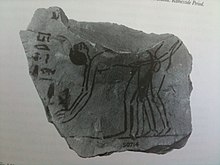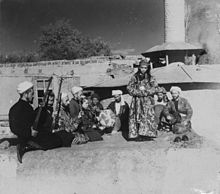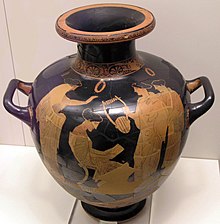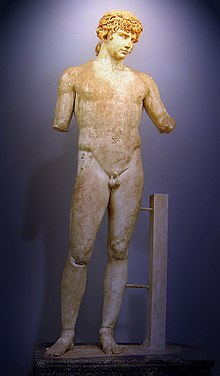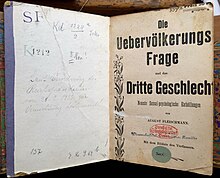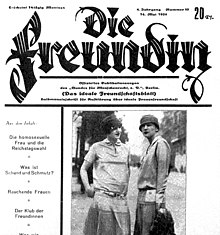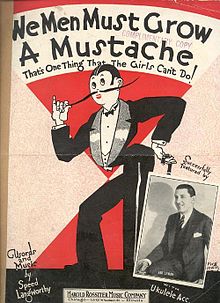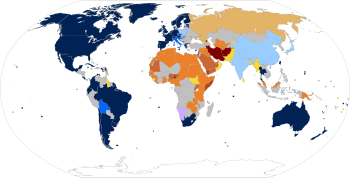| LGBTQ history | |
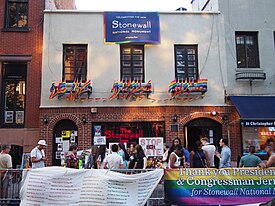
The Stonewall Inn in the gay village of Greenwich Village, Manhattan, site of the June 28, 1969 Stonewall riots, the cradle of the modern worldwide LGBT rights movement, is adorned with flags depicting the colors of the rainbow.
|
LGBT history dates back to the first recorded instances of same-sex love and sexuality of ancient civilizations, involving the history of lesbian, gay, bisexual and transgender (LGBT) peoples and cultures around the world. What survives after many centuries of persecution—resulting in shame, suppression, and secrecy—has only in more recent decades been pursued and interwoven into more mainstream historical narratives.
In 1994 the annual observance of LGBT History Month began in the US, and it has since been picked up in other countries. This observance involves highlighting the history of the people, LGBT rights and related civil rights movements. It is observed during October in the United States, to include National Coming Out Day on October 11. In the United Kingdom, it is observed during February, to coincide with a major celebration of the 2005 abolition of Section 28, which had prohibited local authorities from promoting homosexuality.
Ancient history
Among historical figures, some were recorded as having relations with others of their own sex — exclusively or together with opposite-sex relations — while others were recorded as only having relations with the opposite sex. However, there are instances of same-sex love and sexuality within almost all ancient civilizations. Additionally, people who are third gender or what we would now think of as intersex have been recorded in almost all cultures across human history.Africa
Anthropologists Stephen Murray and Will Roscoe reported that women in Lesotho engaged in socially sanctioned "long term, erotic relationships," named motsoalle. E. E. Evans-Pritchard also recorded that male Azande warriors (in the northern Congo) routinely took on boy-wives between the ages of twelve and twenty, who helped with household tasks and participated in intercrural sex with their older husbands. The practice had died out by the early 20th century, after Europeans had gained control of African countries, but was recounted to Evans-Pritchard by the elders with whom he spoke.Ancient Egypt
A Ramesside period ostraca, depicting a pederastic couple (a boy and man) having sex together
Ostraca dating from the Ramesside Period have been found which depict hastily drawn images of homosexual as well as heterosexual sex. The duo Khnumhotep and Niankhkhnum, manicurists in the Palace of King Niuserre during the Fifth Dynasty of Egyptian pharaohs, circa 2400 BC. are speculated to have been gay based on a representation of them embracing nose-to-nose in their shared tomb. King Neferkare and General Sasenet, a Middle Kingdom
story, has an intriguing plot revolving around a king's clandestine gay
affair with one of his generals. It may reference the actual Pharaoh Pepi II, who was likely gay.
Early modern Egypt
The Siwa Oasis was of special interest to anthropologists and sociologists
because of its historical acceptance of male homosexuality. The
practice probably arose because from ancient times unmarried men and adolescent
boys were required to live and work together outside the town of Shali,
secluded for several years from any access to available women. In 1900,
the German egyptologist George Steindorff reported that, "the feast of marrying a boy was celebrated with great pomp, and the money paid for a boy sometimes amounted to fifteen pound, while the money paid for a woman was a little over one pound." The archaeologist Count Byron de Prorok reported in 1937 that "an enthusiasm could not have been approached even in Sodom... Homosexuality was not merely rampant, it was raging...Every dancer had his boyfriend...[and] chiefs had harems of boys.
Walter Cline noted that, "all normal Siwan men and boys practice sodomy...the
natives are not ashamed of this; they talk about it as openly as they
talk about love of women, and many if not most of their fights arise
from homosexual competition....Prominent men lend their sons to each
other. All Siwans know the matings which have taken place among their sheiks and their sheiks' sons....Most of the boys used in sodomy are between twelve and eighteen years of age." In the late 1940s, a Siwan merchant told the visiting British novelist Robin Maugham that the Siwan men "will kill each other for boy. Never for a woman".
Americas
Dance to the Berdache
Sac and Fox Nation ceremonial dance to celebrate the two-spirit person. George Catlin (1796–1872); Smithsonian Institution, Washington, DC
Sac and Fox Nation ceremonial dance to celebrate the two-spirit person. George Catlin (1796–1872); Smithsonian Institution, Washington, DC
Among Indigenous peoples of the Americas
prior to European colonization, a number of nations had respected roles
for homosexual, bisexual, and gender-nonconforming individuals; in many
indigenous communities, these social and spiritual roles are still
observed. While each indigenous culture has its own names for these individuals, a modern, pan-Indian term that has been adopted by consensus is "Two-Spirit".
Typically this individual is recognized early in life, and raised in
the appropriate manner, learning from the Elders the customs, spiritual,
and social duties fulfilled by these special people in the community.
Ancient Assyria
The Middle Assyrian Law Codes (1075 BC) state: If a man has intercourse with his brother-in-arms, they shall turn him into a eunuch. This is the earliest known law condemning the act of male-to-male intercourse in the military. Despite these laws, sex crimes were punished identically whether they were homosexual or heterosexual in the Assyrian society. Homosexuality was also an integral part of temple life in parts of Mesopotamia, and no blame appears to have attached to its practice outside of worship. Freely pictured art of anal intercourse, practiced as part of a religious ritual, dated from the 3rd millennium BC and onwards.
Furthermore, the article 'Homosexualität' in Reallexicon der Assyriologie
states, "Homosexuality in itself is thus nowhere condemned as
licentiousness, as immorality, as social disorder, or as transgressing
any human or divine law. Anyone could practice it freely, just as anyone could visit a prostitute, provided it was done without violence and without compulsion, and preferably as far as taking the passive role was concerned, with specialists. That there was nothing religiously amiss with homosexual love between men
is seen by the fact that they prayed for divine blessing on it. It
seems clear that the Mesopotamians saw nothing wrong in homosexual acts
between consenting adults".
Ancient China
A woman spying on a pair of male lovers. China, Qing Dynasty.
Homosexuality has been acknowledged in China since ancient times.
Scholar Pan Guangdan (潘光旦) came to the conclusion that nearly every emperor in the Han Dynasty had one or more male sex partners. Homosexuality in China, known as the passions of the cut peach
and various other euphemisms has been recorded since approximately 600
BCE. Homosexuality was mentioned in many famous works of Chinese
literature.
The instances of same-sex affection and sexual interactions described in the classical novel Dream of the Red Chamber
seem as familiar to observers in the present as do equivalent stories
of romances between heterosexual people during the same period. Confucianism, being primarily a social and political philosophy, focused little on sexuality, whether homosexual or heterosexual.
There are also descriptions of lesbians in some history books. It is believed homosexuality was popular in the Song, Ming and Qing dynasties.
Ancient India
Throughout Hindu and Vedic
texts there are many descriptions of saints, demigods, and even the
Supreme Lord transcending gender norms and manifesting multiple
combinations of sex and gender. There are several instances in ancient
Indian epic poetry of same sex depictions and unions by gods and
goddesses. There are several stories of depicting love between same
sexes especially among kings and queens. Kamasutra,
the ancient Indian treatise on love talks about feelings for same
sexes. There are several depictions of same-sex sexual acts in temples
like Khajuraho. Several Mughal noblemen and emperors and other Muslim rulers of South Asia are known to have had homosexual inclinations. In South Asia the Hijra are a caste of third-gender, or transgender group who live a feminine role. Hijra may be born male or intersex, and some may have been born female.[31]
Ancient Israel
The ancient Law of Moses (the Torah) forbids men from lying with men (i.e., from having intercourse) in Leviticus 18 and gives a story of attempted homosexual rape in Genesis 19, in the story of Sodom and Gomorrah,
after which the cities were soon destroyed with "brimstone and fire,
from the Lord" and the death penalty was prescribed to its inhabitants
and to Lot's wife who was tuned into a pillar of salt because she turned
back to watch the cities' destruction. In Deuteronomy 22:5, cross-dressing is condemned as "abominable".
Middle Assyrian Law Codes dating 1075 BC states: "If a man have intercourse with his brother-in-arms, they shall turn him into a eunuch".
Ancient Japan
In Japan, several Heian diaries which contain references to homosexual acts exist as well. Some of these also contain references to emperors involved in homosexual relationships and to "handsome boys retained for sexual purposes" by emperors. In other literary works can be found references to what Leupp has called "problems of gender identity", such as the story of a youth's falling in love with a girl who is actually a cross-dressing male. Japanese shunga are erotic pictures which include same-sex and opposite-sex love.
Ancient Persia
Dance of a bacchá (dancing boy) Samarkand, (ca 1905–1915), photo Sergei Mikhailovich Prokudin-Gorskii. Library of Congress, Washington, DC.
In pre-modern Islam
there was a "widespread conviction that beardless youths possessed a
temptation to adult men as a whole, and not merely to a small minority
of deviants."
Classical antiquity in Europe
Ancient Celts
According to Aristotle,
although most "belligerent nations" were strongly influenced by their
women, the Celts were unusual because their men openly preferred male
lovers (Politics II 1269b). H. D. Rankin in Celts and the Classical World notes that "Athenaeus echoes this comment (603a) and so does Ammianus (30.9). It seems to be the general opinion of antiquity." In book XIII of his Deipnosophists, the Roman Greek rhetorician and grammarian Athenaeus, repeating assertions made by Diodorus Siculus in the 1st century BC (Bibliotheca historica
5:32), wrote that Celtic women were beautiful but that the men
preferred to sleep together. Diodorus went further, stating that "the
young men will offer themselves to strangers and are insulted if the
offer is refused". Rankin argues that the ultimate source of these
assertions is likely to be Poseidonius and speculates that these authors may be recording male "bonding rituals".
Ancient Greece
Male couple (erastes and eromenos) kissing (Attic red-figured cup, ca. 480 BC)
Sappho reading to her companions on an Attic vase of c. 435 BC.
The earliest documents concerning same-sex relationships come from ancient Greece.
Such relationships did not replace marriage between man and woman, but
occurred before and beside it. A mature man would not usually have a
mature male mate (with exceptions such as Alexander the Great and the same-aged Hephaestion) but the older man would usually be the erastes (lover) to a young eromenos (loved one). Men could also seek adolescent boys
as partners as shown by some of the earliest documents concerning
same-sex pederastic relationships, which come from ancient Greece. Often
they were favored over women. Though slave boys could be bought, free
boys had to be courted, and ancient materials suggest that the father
also had to consent to the relationship.
Such documents depict a world in which relationships with women
and relationships with youths were the essential foundation of a normal
man's love life. Same-sex relationships
were a social institution variously constructed over time and from one
city to another. The formal practice, an erotic yet often restrained
relationship between a free adult male and a free adolescent was valued
for its pedagogic benefits and as a means of population control, though occasionally was blamed for causing disorder.
Plato praised its benefits in his early writings [e.g., Phaedrus in the Symposium (385-370 BC)] but in his late works proposed its prohibition [e.g., in Laws (636D & 835E)). In the Symposium (182B-D), Plato equates acceptance of homosexuality with democracy and its suppression with despotism,
and wrote that homosexuality "is shameful to barbarians because of
their despotic governments, just as philosophy and athletics are, since
it is apparently not in best interests of such rulers to have great
ideas engendered in their subjects, or powerful friendships or physical
unions, all of which love is particularly apt to produce". Aristotle, in the Politics, dismissed Plato's ideas about abolishing homosexuality; he explains that barbarians like the Celts accorded it a special honor, while the Cretans used it to regulate the population.
Female youths are depicted surrounding Sappho in this painting of Lafond "Sappho sings for Homer", 1824.
The ideal held that both partners would be inspired by love symbolized by Eros,
the erastes unselfishly providing education, guidance, and appropriate
gifts to his eromenos, who became his devoted pupil and assistant, while
the sexuality theoretically remained short of penetrative acts and
supposedly would consist primarily of the act of frottage or intercrural sex. Although this was the ideal, realistically speaking, it is probable that in many such relationships fellatio and penetrative anal intercourse
did occur. The hoped-for result was the mutual improvement of both
erastes and eromenos, each doing his best to excel in order to be worthy
of the other. If one was open about one's homosexuality then they were
exiled or in some cases executed because it was regarded as a duty to
one's ethnic group to reproduce.
Kenneth J. Dover, followed by Michel Foucault and Halperin,
assumed that it was considered improper for the eromenos to feel
desire, as that would not be masculine. However, Dover's claim has been
questioned in light of evidence of love poetry
which suggests a more emotional connection than earlier researchers
liked to acknowledge. Some research has shown that ancient Greeks
believed semen, more specifically sperm, to be the source of knowledge, and that these relationships served to pass wisdom on from the erastes to the eromenos within society.
Sappho, born on the island of Lesbos, was included by later Greeks in the canonical list of nine lyric poets. The adjectives deriving from her name and place of birth (Sapphic and Lesbian) came to be applied to female homosexuality beginning in the 19th century.
Sappho's poetry centers on passion and love for various personages and
both genders. The narrators of many of her poems speak of infatuations and love (sometimes requited, sometimes not) for various females, but descriptions of physical acts between women are few and subject to debate.
Ancient Rome
Statue of Antinous (Delphi), polychrome Parian marble depicting Antinous, made during the reign of Hadrian (r. 117–138 AD), his lover
In Ancient Greece and Phrygia, and later in the Roman Republic, the Goddess Cybele was worshiped by a cult of people who castrated themselves, and thereafter took female dress and referred to themselves as female. These early transgender figures have also been referred by several authors as early role models.
In Ancient Rome
the young male body remained a focus of male sexual attention, but
relationships were between older free men, and slaves or freed youths
who took the receptive role in sex. All the emperors, with the exception
of Claudius, took male lovers. The Hellenophile emperor Hadrian is renowned for his relationship with Antinous.
In Roman patriarchal society, it was socially acceptable for an adult male citizen to take the penetrative role in same-sex relations. Freeborn male minors were strictly protected from sexual predators (see Lex Scantinia),
and men who willingly played the "passive" role in homosexual relations
were disparaged. No law or moral censure was directed against
homosexual behaviors as such, as long as the citizen took the dominant
role with a partner of lower status such as a slave, prostitute, or someone considered infamis, of no social standing.
The Roman emperor Elagabalus is depicted as transgender by some modern writers. Elagabalus was said to be "delighted to be called the mistress, the wife, the queen of Hierocles." Supposedly, great wealth was offered to any surgeon who was able to give Elagabalus female genitalia.
During the Renaissance, wealthy cities in northern Italy—Florence and Venice
in particular—were renowned for their widespread practice of same-sex
love, engaged in by a considerable part of the male population and
constructed along the classical pattern of Greece and Rome. Attitudes toward homosexual behavior changed when the Empire fell under Christian rule; see for instance legislation of Justinian I.
South Pacific
In many societies of Melanesia, especially in Papua New Guinea, same-sex relationships were, until the middle of the last century, an integral part of the culture. The Etoro and Marind-anim, for example, viewed heterosexuality
as sinful and celebrated homosexuality instead. In many traditional
Melanesian cultures a pre-pubertal boy would be paired with an older
adolescent who would become his mentor and who would "inseminate" him
(orally, anally, or topically, depending on the tribe) over a number of
years in order for the younger to also reach puberty.
The Middle Ages
Same-sex scholarly 'empires of the mind' were common in medieval Middle Eastern cultures, as seen in their poetry on same-sex love.
According to John Boswell, author of Christianity, Social Tolerance and Homosexuality, there were same-sex Christian monastic communities and other religious orders in which homosexuality thrived. According to Chauncey et al. (1989), the book "offered a revolutionary interpretation of the Western tradition, arguing that the Roman Catholic Church had not condemned gay people
throughout its history, but rather, at least until the twelfth century,
had alternately evinced no special concern about homosexuality or
actually celebrated love between men."
Boswell was also the author of Same-Sex Unions in Pre-Modern Europe (New York: Villard, 1994) in which he argues that the adelphopoiia liturgy was evidence that attitude of the Christian church towards homosexuality has changed over time, and that early Christians did on occasion accept same-sex relationships.
His work attracted great controversy, as it was seen by many as merely
an attempt for Boswell to justify his homosexuality and Roman Catholic
faith. For instance, R. W. Southern points out that homosexuality had
been condemned extensively by religious leaders and medieval scholars
well before the 12th century; he also points to the penitentials which were common in early medieval society, and many of which include homosexuality as among the serious sins.
Bennett and Froide, in "Singlewomen in the European Past", note: "Other
single women found emotional comfort and sexual pleasure with women. The
history of same-sex relations between women in medieval and early modern
Europe is exceedingly difficult to study, but there can be no doubt of its
existence. Church leaders worried about lesbian sex; women expressed,
practiced, and were sometimes imprisoned or even executed for same-sex love;
and some women cross-dressed in order to live with other women as married
couples." They go on to note that even the seemingly modern word "lesbian"
has been traced back as far as 1732, and discuss lesbian subcultures, but
add, "Nevertheless, we certainly should not equate the single state with
lesbian practices." While same-sex relationships among men were highly
documented and condemned, "Moral theologians did not pay much attention to
the question of what we would today call lesbian sex, perhaps because
anything that did not involve a phallus did not fall within the bounds of
their understanding of the sexual. Some legislation against lesbian
relations can be adduced for the period, mainly
involving the use of "instruments," in other words,
dildoes."
Persecutions against homosexuality rose during the High Middle Ages, reaching their height during the Medieval Inquisitions, when the sects of Cathars and Waldensians
were accused of fornication and sodomy, alongside accusations of
satanism. In 1307, accusations of sodomy and homosexuality were major
charges leveled during the Trial of the Knights Templar. The theologian Thomas Aquinas was influential in linking condemnations of homosexuality with the idea of natural law,
arguing that "special sins are against nature, as, for instance, those
that run counter to the intercourse of male and female natural to
animals, and so are peculiarly qualified as unnatural vices."
Muslim—often Sufi—poets in medieval Arab lands and in Persia
wrote odes to the beautiful wine boys who served them in the taverns.
In many areas the practice survived into modern times, as documented by Richard Francis Burton, André Gide, and others. Homoerotic
themes were present in poetry and other literature written by some
Muslims from the medieval period onwards and which celebrated love
between men. In fact these were more common than expressions of
attraction to women.
Persian poets, such as Sa'di (d. 1291), Hafiz (d. 1389), and Jami
(d. 1492), wrote poems replete with homoerotic allusions. The two most
commonly documented forms were commercial sex with transgender young
women or males enacting transgender roles exemplified by the köçeks and the bacchás, and Sufi
spiritual practices in which the practitioner admired the form of a
beautiful boy in order to enter ecstatic states and glimpse the beauty
of god.
The Renaissance
The Renaissance saw intense oppression of homosexual relationships by the Roman Catholic Church.
Homosexual activity radically passes from being completely legal in the
most of Europe to incurring the death penalty in most European states. In France,
first-offending sodomites lost their testicles, second offenders lost
their penis, and third offenders were burned. Women caught in same-sex
acts would be mutilated and executed as well. Thomas Aquinas argues that sodomy is second only to murder in the ranking of sins. The church used every means at its disposal to fight what it considered to be the "corruption of sodomy". Men were fined or jailed; boys were flogged. The harshest punishments, such as burning at the stake, were usually reserved for crimes committed against the very young, or by violence. The Spanish Inquisition
begins in 1480, sodomites were stoned, castrated, and burned. Between
1540 and 1700, more than 1,600 people were prosecuted for sodomy. In 1532 the Holy Roman Empire made sodomy punishable by death. The following year King Henry VIII passed the Buggery Act 1533 making all male-male sexual activity punishable by death.
Florentine homosexuality
Florence had a widespread homosexual culture, which included age-structured relationships. In 1432 the city established Gli Ufficiali di Notte
(The Officers of the Night) to root out the practice of sodomy. From
that year until 1502, the number of men charged with sodomy numbered
more than 17,000, of whom 3,000 were convicted. This number also
included heterosexual sodomy. This also gave rise to a number of
proverbs illuminating the views of the common people towards the
practice; among them: "If you crave joys, tumble some boys."
Association of homosexuality with foreignness
The reputation of Florence is also reflected in the fact that the Germans adopted the word Florenzer to refer to a "sodomite".
The association of foreignness with homosexuality gradually became a
cornerstone of homophobic rhetoric throughout Europe, and it was used in
a calumnious perspective. For example, the French would call
"homosexuality" the "Italian vice" in the 16th and 17th centuries, the
"English vice" in the 18th century, the mœurs orientales (oriental mores) in the 19th century, and the "German vice" starting from 1870 and into the 20th century.
Literature
The Church could not repress all expressions of homoerotic desire. One of the most famous examples is a tongue-in-cheek philosophic defense of the practice provided by Antonio Rocco, in his infamous L'Alcibiade, fanciullo a scola (Alcibiades the Schoolboy,
in English) a dialogue in which a teacher seeks to use philosophy to
convince a male student to have sex with him. However, given the
tongue-in-cheek nature of the writing, it seems unclear whether it is
meant to be satire or genuine under the pretense of a joke.
Modern Europe
Vita homosexualis, a 1902 collection of August Fleischmann's popular pamphlets on the third sex and against §175 - a copy from the library of the Wissenschaftlich-humanitäres Komitee, confiscated on 6 May 1933, annotated on the endpaper: "Destined for destruction in accordance with the Reichspresident's decree of 28 February 1933!" and hidden from the public (label "Secr.") as Nazi plunder at the Prussian State Library.
Psychology and terminology shifts
The developing field of psychology was the first way homosexuality
could be directly addressed aside from Biblical condemnation. In Europe,
homosexuality had been part of case studies since the 1790s with Johann
Valentin Müller's work.
The studies of this era tended to be rigorous examination of
"criminals," looking to confirm guilt and establish patterns for future
prosecutions. Ambroise Tardieu in France believed he could identify
"pederasts" affirming that the sex organs are altered by homosexuality
in his 1857 publishing.
François Charles's exposé, Les Deux Prostitutions: études du pathologie
sociale, (The Two Prostitutions: Study of the Social Pathology)
developed methods for police to persecute through meticulous
documentation of homosexuality. Others include Johann Caspar and Otto Westphal, Karl Ulrichs. Richard von Krafft-Ebing's 1886 publication, Psychopathia Sexualis, was the most widely translated work of this kind.
He and Ulrichs believed that homosexuality was congenitally based, but
Krafft-Ebing differed; in that, he asserted that homosexuality was a
symptom of other psychopathic behavior that he viewed to be an inherited
disposition to degeneracy.
Degeneracy became a widely acknowledged theory for homosexuality during the 1870s and 80s.
It spoke to the eugenic and social Darwin theories of the late 19th
century. Benedict Augustin Morel is considered the father of degeneracy
theory.
His theories posit that physical, intellectual, and moral abnormalities
come from disease, urban over-population, malnutrition, alcohol, and
other failures of his contemporary society.
An important shift in the terminology of homosexuality was
brought about by the development of psychology's inquisition into
homosexuality. "Contrary sexual feeling,"
as Westphal's phrased, and the word "homosexual" itself made their way
into the Western lexicons. Homosexuality had a name aside from the
ambiguous term "sodomy" and the elusive "abomination." As Michel
Foucault phrases, "the sodomite had been a temporary aberration; the
homosexual was now a species."
An addendum to the terminology of homosexuality is the seemingly
ever-changing acronym, with its roots in the 1980s when female
homosexuals began to identify themselves as lesbians instead of gay.
This led to references of "gay and lesbian" every time homosexuals were
discussed in the media. Non-heterosexuals such as bisexual people and
those who are transgender have also been classed alongside gay people
and lesbians, resulting in the popular LGBT acronym (lesbian, gay,
bisexual, transgender). However, the acronym is not set in stone; it has
sometimes appeared as LGBTQ (to include questioning or queer people).
Homosexuality in eighteenth-century Great Britain
Various authors wrote on the topic of homosexuality. In 1735, Conyers
Place wrote "Reason Insufficient Guide to Conduct Mankind in Religion." In 1749, Thomas Cannon wrote "Ancient and Modern Pederasty Investigated and Exemplified." In August, 1772, "Morning Chronicle" publishes a series of letters to the editor about the trial of Captain Robert Jones. In 1773, Charles Crawford wrote "A Dissertation on the Phaedon of Plato."
Molly houses appeared in 18th century London and other large cities. A Molly house is an archaic 18th century English term for a tavern or private room where homosexual and cross-dressing
men could meet each other and possible sexual partners. Patrons of the
Molly house would sometimes enact mock weddings, sometimes with the
bride giving birth. Margaret Clap (?—circa 1726), better known as Mother Clap, ran such a Molly house from 1724 to 1726 in Holborn,
London. She was also heavily involved in the ensuing legal battles
after her premise was raided and shut down. Molly houses were perhaps
the first precursors to the modern gay bar.
Decriminalization of homosexuality in France
Written on July 21, 1776, the Letter LXIII became infamous for its frank talk of human sexuality. Mathieu-François Pidansat de Mairobert
published the letter in his 1779 book, "L'Espion Anglois, Ou
Correspondance Secrete Entre Milord All'eye et Milord Alle'ar" (aka
"L'Observateur Anglais or L'Espion Anglais") ("The English Spy, or
Secret Correspondence Between my Lord and my Lord All'eye Alle'ar [aka
The English Observer or The English Spy]").
In 1791, Revolutionary France
(and Andorra) adopted a new penal code which no longer criminalized
sodomy. France thus became the first West European country to
decriminalize homosexual acts between consenting adults.
Oscar Wilde
Oscar Wilde,
the Irish author and playwright, played an important role in bringing
homosexuality into the public eye. The scandal in British society and
subsequent court case from 1895–6 was highly discussed not only in
Europe, but also in America, although newspapers like the New York Times
concentrated on the question of blackmail, only alluding to the
homosexual aspects as having "a curious meaning," in the first
publication on April 4, 1895. After Wilde's arrest, the April 6 New York Times
discussed Wilde's case as a question of "immorality" and did not
specifically address homosexuality, discussing the men "some as young as
18" that were brought up as witnesses. Inspired by Wilde's renown and homosexuality, gay activist Craig Rodwell founded the first United States LGBTQ bookstore on November 24, 1967 and called it the Oscar Wilde Memorial Bookshop.
The emancipation movement in Germany, 1890s–1934
The Gay Club Eldorado in Berlin
Lesbian periodical Die Freundin, 1928
Prior to the Third Reich, Berlin was a liberal city, with many gay bars, nightclubs and cabarets. There were even many drag bars where tourists straight and gay would enjoy female impersonation acts. Hitler decried cultural degeneration, prostitution and syphilis in his book Mein Kampf, blaming at least some of the phenomena on Jews.
Berlin also had the most active LGBT rights movements in the world at the time. Jewish doctor Magnus Hirschfeld had co-founded the Scientific-Humanitarian Committee (Wissenschaftlich-humanitäres Komitee, WhK) in Berlin in 1897 to campaign against the notorious "Paragraph 175" of the Penal Code that made sex between men
illegal. It also sought social recognition of homosexual and
transgender men and women. It was the first public gay rights
organization. The Committee had branches in several other countries,
thereby being the first international LGBT organization, although on a
small scale. In 1919, Hirschfeld had also co-founded the Institut für Sexualwissenschaft (Institute for Sex Research), a private sexology research institute. It had a research library
and a large archive, and included a marriage and sex counseling office.
In addition, the institute was a pioneer worldwide in the call for civil rights
and social acceptance for homosexual and transgender people.
As a leading city for homosexuals during the 1920, Berlin had clubs
and even newspapers for both lesbians and gay men. The lesbian magazine Die Freundin was started by Friedrich Radszuweit and the gay men's magazine Der Eigene had already started in 1896 as the world's first gay magazine. The first gay demonstration ever took place in Nollendorfplatz in 1922 in Berlin, gathering 400 homosexuals.
Spanish Anarcha-feminist and lesbian Lucía Sánchez Saornil, co-founder of Mujeres Libres and socialist libertarian figure of Spanish Revolution of 1936.
Nazi Germany
Under the rule of Nazi Germany,
about 50,000 men were sentenced because of their homosexuality and
thousands of them died in concentration camps. Conditions for gay men in
the camps was especially rough; they faced not only persecution from
German soldiers, but also other prisoners, and many gay men were
reported to die of beatings. Female homosexuality was not, technically, a
crime and thus gay women were generally not treated as harshly as gay
men. Although there are some scattered reports that gay women were
sometimes imprisoned for their sexuality, most would have been
imprisoned for other reasons, i.e. "anti-social".
Alan Turing
In Britain, the view of homosexuality as the mark of a deviant mind
was not limited to the psychiatric wards of hospitals but also the
courts. An extremely famous case was that of Alan Turing, a British mathematician and theoretician. During WWII, Turing worked at Bletchley Park and was one of the major architects of the Colossus computer, designed to break the Enigma codes of the Nazi war machine. For the success of this, he received the Order of the British Empire in 1945.
Unfortunately, in spite of all his brilliance and the services rendered
to his country, Turing was also openly homosexual and in the early
1950s this fact came to the attention of the British government when he
was arrested under section 11 of an 1885 statute of "gross indecency".
At the time there was great fear that Turing's sexuality could be
exploited by Soviet spies, and so he was sentenced to choosing between
jail and injections of synthetic estrogen. The choice of the latter
lead him to massive depression and committing suicide at the age of 41,
biting into a poisoned apple.
It is estimated that an additional 50-75,000 men were persecuted under
this law, with only partial repeal taking place in 1967 and the final
measure of it in 2003.
United States of America
18th and 19th century
Before the American Civil War and the massive population growth of
the Post-Civil War America, the majority of the American population was
rural. Homosexuality remained an unseen and taboo concept in society,
and the word "homosexuality" was not coined until 1868 by
German-Hungarian Karoly Maria Kertbeny (who advocated decriminalization).
During this era, homosexuality fell under the umbrella term "sodomy"
that comprised all forms of nonproductive sexuality (masturbation and
oral sex were sometimes excluded). Without urban sub-cultures or a name
for self-definition, group identification and self-consciousness was
unlikely.
Mainstream interpretation of Leviticus 20:13, Romans 1:26-7 and the destruction of Sodom and Gomorrah were the justification for the severe penalties facing those accused of "sodomy."
Most of the laws around homosexuality in the colonies were derived from
the English laws of "buggery," and the punishment in all American
colonies was death. The penalty for attempted sodomy (both homosexuality
and bestiality) was prison, whipping, banishment, or fines. Thomas
Jefferson suggested castration as the punishment for sodomy, rape, and
polygamy in a proposed revision of the Virginia criminal code near the
end of the 18th century.
Pennsylvania was the first state to repeal the death penalty for
"sodomy" in 1786 and within a generation all the other colonies followed
suit (except North and South Carolina that repealed after the Civil
War).
Along with the removal of the death penalty during this generation,
legal language shifted away from that of damnation to more dispassionate
terms like "unmentionable" or "abominable" acts.
Aside from sodomy and "attempted sodomy" court cases and a few public
scandals, homosexuality was seen as peripheral in mainstream society.
Lesbianism had no legal definition largely given Victorian notions of
female sexuality.
A survey of sodomy law enforcement during the nineteenth century
suggests that a significant minority of cases did not specify the gender
of the "victim" or accused. Most cases were argued as non-consensual or
rape. The first prosecution for consensual sex between people of the same gender was not until 1880.
In response to increasing visibility of alternative genders, gender
bending, and homosexuality, a host of laws against vagrancy, public
indecency, disorderly conduct, and indecent exposure was introduced
across the United States. "Sodomy" laws also shifted in many states over
the beginning of the twentieth century to address homosexuality
specifically (many states during the twentieth century made heterosexual
anal intercourse legal). In some states, these laws would last until they were repealed by the federal government in 2004 with the Lawrence decision.
Male ideal and the 19th century
Homosexual identity found its first social foothold in the 19th
Century not in sexuality or homoerotica, but in idealized conception of
the wholesome and loving male friendship during the 19th Century. Or as
contemporary author Theodore Winthrop in Cecil Dreeme writes, "a friendship I deemed more precious than the love of women."
This ideal came from and was enforced by the male-centric institutions
of boy's boarding schools, all-male colleges, the military, the
frontier, etc. – fictional and non-fiction accounts of passionate male
friendships became a theme present in American Literature and social
conceptions of masculinity.
New York, as America's largest city exponentially growing during
the 19th Century (doubling from 1800–20 and again by 1840 to a
population of 300,000), saw the beginnings of a homosexual subculture
concomitantly growing with the population. Continuing the theme of loving male friendship, the American poet, Walt Whitman arrived in New York in 1841.
He was immediately drawn to young working class men found in certain
parks, public baths, the docks, and some bars and dance halls. He kept records of the men and boys, usually noting their ages, physical characteristics, jobs, and origins. Dispersed in his praise of the city are moments of male admiration, such as in Calamus— "frequent and swift flash of eyes offering me robust, athletic love" or in poem Crossing Brooklyn Ferry, where he writes:
"Was call'd by my nighest name by clear loud voices of young men as they saw me / approaching or passing, / Felt their arms on my neck as I stood, or the negligent leaning of their flesh against me as / I sat, / Saw many I loved in the street or ferry-boat or public assembly, yet never told them a / word, / Lived the same life with the rest, the same old laughing, gnawing, sleeping, / Play'd the part that still looks back on the actor or actress, / The same old role, the role that is what we make it, as great as we like, / Or as small as we like, or both great and small."
Sometimes Whitman's writing verged on explicit, such as in his
poem, Native Moments— "I share the midnight orgies of young men / I pick
out some low person for my dearest friend. He shall be lawless, rude,
illiterate."
Poems like these and Calamus (inspired by Whitman's treasured friends
and possible lover, Fred Vaughan who lived with the Whitman family in
the 1850s) and the general theme of manly love, functioned as a
pseudonym for homosexuality.
The developing sub-community had a coded voice to draw more
homosexuals to New York and other growing American urban centers.
Whitman did, however, in 1890 denounce any sexuality in the comradeship
of his works and historians debate whether he was a practicing
homosexual, bisexual, etc. But this denouncement shows that homosexuality had become a public question by the end of the 19th Century.
Twenty years after Whitman came to New York, Horatio Alger
continued the theme of manly love in his stories of the young Victorian self-made man. He came to New York fleeing from a public scandal with a young man in Cape Cod that forced him to leave the ministry, in 1866.
Late 19th century
We'wha was a relatively modern Ihamana (Two-Spirit) of the Native American Zuni tribe.
The anthropologist Matilda Coxe Stevenson, who wrote about We'wha,
hosted her on a visit to Washington D.C. in 1886 during which she met
President Grover Cleveland. She was revered by her tribe for her skill
at weaving and pottery, as well as taking part in community ceremonies
and rituals. Her life was originally documented by anthropologist Matilda Coxe Stevenson in the late 19th century.
Early 20th century
In 1908, the first American defense of homosexuality was published. The Intersexes: A History of Similisexualism as a Problem in Social Life, was written by Edward Stevenson under the pseudonym Xavier Mayne. This 600-page defense detailed Classical examples, but also modern literature and the homosexual subcultures of urban life.
He dedicated the novel to Krafft-Ebing because he argued homosexuality
was inherited and, in Stevenson's view and not necessarily
Krafft-Ebing's, should not face prejudice. He also wrote one of the
first homosexual novels— Imre: A Memorandum.
Also in this era, the earliest known open homosexual in the United
States, Claude Hartland, wrote an account of his sexual history.
He affirmed that he wrote it to affront the naivety surrounding
sexuality. It was in response to the ignorance he saw while being
treated by doctors and psychologists that failed to "cure" him. Hartland wished his attraction to men could be solely "spiritual," but could not escape the "animal."
By this time, society was slowly becoming aware of the homosexual
subculture. In an 1898 lecture in Massachusetts, a doctor gave a
lecture on this development in modern cities.
With a population around three million at the turn of the 20th century,
New York's queer subculture had a strong sense of self-definition and
began redefining itself on its own terms. "Middle class queer,"
"fairies," were among the terminology of the underground world of the
Lower East Side.
But with this growing public presence, backlash occurred. The YMCA, who
ironically promoted a similar image to that of the Whitman's praise of
male brotherhood and athletic prowess, took a chief place in the purity
campaigns of the epoch. Anthony Comstock, a salesman and leader of YMCA
in Connecticut and later head of his own New York Society for the
Suppression of Vice successfully pressed Congress and many state
legislatures to pass strict censorship laws.
Ironically, the YMCA became a site of homosexual conduct. In 1912, a
scandal hit Oregon where more than 50 men, many prominent in the
community were arrested for homosexual activity. In reaction to this
scandal conflicting with public campaigns, YMCA leadership began to look
the other way on this conduct.
1920s
Sheet music poking fun at the masculine traits many women adopted during the 1920s.
The 1920s ushered in a new era of social acceptance of minorities and
homosexuals, at least in heavily urbanized areas. This was reflected in
many of the films
of the decade that openly made references to homosexuality. Even
popular songs poked fun at the new social acceptance of homosexuality.
One of these songs had the title "Masculine Women, Feminine Men." It was released in 1926 and recorded by numerous artists of the day and included the following lyrics:
| “ | Masculine women, Feminine men
Which is the rooster, which is the hen? It's hard to tell 'em apart today! And, say! Sister is busy learning to shave, Brother just loves his permanent wave, It's hard to tell 'em apart today! Hey, hey! Girls were girls and boys were boys when I was a tot, Now we don't know who is who, or even what's what! Knickers and trousers, baggy and wide, Nobody knows who's walking inside, Those masculine women and feminine men! |
” |
Homosexuals received a level of acceptance that was not seen again
until the 1970s. Until the early 1930s, gay clubs were openly operated,
commonly known as "pansy clubs". The relative liberalism of the decade
is demonstrated by the fact that the actor William Haines,
regularly named in newspapers and magazines as the number-one male
box-office draw, openly lived in a gay relationship with his lover, Jimmie Shields. Other popular gay actors/actresses of the decade included Alla Nazimova and Ramon Novarro. In 1927, Mae West wrote a play about homosexuality called The Drag, and alluded to the work of Karl Heinrich Ulrichs. It was a box-office success. West regarded talking about sex as a basic human rights issue, and was also an early advocate of gay rights.
With the return of conservatism in the 1930s, the public grew
intolerant of homosexuality, and gay actors were forced to choose
between retiring or agreeing to hide their sexuality.
Late 1930s
By 1935, the United States had become conservative once again. Victorian values
and mores, which had been widely ridiculed during the 1920s became
fashionable once again. During this period, life was harsh for
homosexuals as they were forced to hide their behavior and identity in
order to escape ridicule and even imprisonment. Many laws were passed
against homosexuals during this period and it was declared to be a
mental illness. Many police forces conducted operations to arrest
homosexuals by using young undercover cops to get them to make
propositions to them.
By the 1930s both fruit and fruitcake terms as well as numerous other words are seen as not only negative but also to mean male homosexual,
although probably not universally. LGBT people were widely diagnosed as
diseased with the potential for being cured, thus were regularly
"treated" with castration, lobotomies, pudic nerve surgery, and electroshock treatment. So transferring the meaning of fruitcake, nutty, to someone who is deemed insane, or crazy, may have seemed rational at the time and many apparently believed that LGBT people were mentally unsound. In the United States, psychiatric institutions ("mental hospitals") where many of these procedures were carried out were called fruitcake factories while in 1960s Australia they were called fruit factories.
World War II
1943 Painting of a World War II WAC Air Controller artist: Dan V. Smith
As the US entered World War II
in 1941, women were provided opportunities to volunteer for their
country and almost 250,000 women served in the armed forces, mostly in
the Women's Army Corps (WAC), two-thirds of whom were single and under the age of twenty-five. Women were recruited with posters showing muscular, short-haired women wearing tight-fitting tailored uniforms. Many lesbians joined the WAC to meet other women and to do men's work. Few were rejected for lesbianism, and found that being strong or having masculine appearance – characteristics associated with homosexual women – aided in the work as mechanics and motor vehicle operators. A popular Fleischmann's Yeast advertisement showed a WAC riding a motorcycle with the heading This is no time to be frail. Some recruits appeared at their inductions wearing men's clothing and their hair slicked back in the classic butch style of out lesbians of the time.
Post-war many women including lesbians declined opportunities to return
to traditional gender roles and helped redefine societal expectations
that fed the women's movement, Civil Rights Movement and gay liberation movement. The war effort greatly shifted American culture and by extension representations in entertainment of both the nuclear family
and LGBT people. In mostly same sex quarters service members were more
easily able to express their interests and find willing partners of all
sexualities.
From 1942 to 1947, WWII conscientious objectors in the US assigned to psychiatric hospitals under Civilian Public Service exposed abuses throughout the psychiatric care system and were instrumental in reforms of the 1940s and 1950s.
Stonewall riots
Although the June 28, 1969, Stonewall riots are generally considered
the starting point of the modern gay liberation movement, a number of
demonstrations and actions took place before that date. These actions,
often organized by local homophile organizations but sometimes
spontaneous, addressed concerns ranging from anti-gay discrimination in
employment and public accommodations to the exclusion of homosexuals
from the United States military to police harassment to the treatment of
homosexuals in revolutionary Cuba. The early actions have been credited
with preparing the LGBT community for Stonewall and contributing to the
riots' symbolic power.
In the autumn of 1959, the police force of New York City's Wagner
administration began closing down the city's gay bars, which had
numbered almost two dozen in Manhattan at the beginning of the year.
This crackdown was largely the result of a sustained campaign by the
right-wing NY Mirror newspaper columnist Lee Mortimer. Existing gay bars were quickly closed and new ones lasted only a short time. The election of John Lindsay
in 1965 signaled a major shift in city politics, and a new attitude
toward sexual mores began changing the social atmosphere of New York. On
April 21, 1966, Dick Leitsch, Craig Rodwell president and vice president respectively of the New York Mattachine Society and Mattachine activist John Timmons staged the Sip-In at Julius' Bar on West 10th Street in Greenwich Village. This resulted in the anti-gay
accommodation rules of the NY State Liquor Authority being overturned
in subsequent court actions. These SLA provisions declared that it was
illegal for homosexuals to congregate and be served alcoholic beverages
in bars. An example of when these laws had been upheld is in 1940 when
Gloria's, a bar that had been closed for such violations, fought the
case in court and lost. Prior to this change in the law, the business of
running a gay bar had to involve paying bribes to the police and Mafia.
As soon as the law was altered, the SLA ceased closing legally licensed
gay bars and such bars could no longer be prosecuted for serving gays
and lesbians. Mattachine pressed this advantage very quickly and Mayor
Lindsay was confronted with the issue of police entrapment in gay bars,
resulting in this practice being stopped. On the heels of this victory,
the mayor cooperated in getting questions about homosexuality removed
from NYC hiring practices. The police and fire departments resisted the
new policy, however, and refused to cooperate. The result of these
changes in the law, combined with the open social- and sexual-attitudes
of the late Sixties, led to the increased visibility of gay life in New
York. Several licensed gay bars were in operation in Greenwich Village and the Upper West Side, as well as illegal, unlicensed places serving alcohol, such as the Stonewall Inn and the Snakepit, both in Greenwich Village. The Stonewall riots
were a series of violent conflicts between gay men, drag queens,
transsexuals, and butch lesbians against a police officer raid in New
York City. The first night of rioting began on Friday, June 27, 1969 at
about 1:20 am, when police raided the Stonewall Inn, a gay bar operating
without a state license in Greenwich Village. Stonewall is considered a turning point for the modern gay rights
movement worldwide. Newspaper coverage of the events was minor in the
city, since, in the Sixties, huge marches and mass rioting had become
commonplace and the Stonewall disturbances were relatively small. It was
the commemorative march one year later, organized by the impetus of Craig Rodwell, owner of the Oscar Wilde Memorial Bookshop, which drew 5,000 marchers up New York City's Sixth Avenue,
that drew nationwide publicity and put the Stonewall events on the
historical map and led to the modern-day pride marches. A new period of
liberalism in the late 1960s began a new era of more social acceptance
for homosexuality which lasted until the late 1970s. In the 1970s, the
popularity of disco music and its culture in many ways made society more accepting of gays and lesbians. Late in 1979, a new religious revival
ushered in the conservatism that would reign in the United States
during the 1980s and made life hard once again for LGBT people.
1980s
The 1980s in LGBT history are marked with the emergence of HIV. During the early period of the outbreak of HIV, the epidemic of HIV was commonly linked to gay men.
In the 1980s a renewed conservative movement spawned a new
anti-gay movement in the United States, particularly with the help of
the Religious Right (Evangelicals in particular). While it is a common belief within some circles of the LGBT community that Ronald Reagan and George H.W. Bush
were anti-gay, some others believe that this is an exaggeration. Ronald
Reagan spoke up for gay equality as early as 1978, when he came out
against Proposition 6,
a ballot initiative that would have dismissed California teachers who
"advocated" homosexuality, even off-campus. As President, he allocated
5.727 Billion dollars from 1982 until 1989 for AIDS research. Socially,
the Reagans were well known for being tolerant of homosexuals. Robert G.
Kaiser's news story in the March 18, 1984, Washington Post.
"The Reagans are also tolerant about homosexual men," Kaiser wrote.
"Their interior decorator, Ted Graber, who oversaw the redecoration of
the White House, spent a night in the Reagans' private White House
quarters with his male lover, Archie Case, when they came to Washington
for Nancy Reagan's 60th birthday party — a fact confirmed for the press
by Mrs. Reagan's press secretary."
However, by the later part of the decade the general public started to
show more sympathy and even tolerance for gays as the toll for AIDS
related deaths continued to rise to include heterosexuals as well as
cultural icons such as Rock Hudson and Liberace,
who also died from the condition. Also, despite the more conservative
period, life in general for gays and lesbians was considerably better in
contrast to the pre-Stonewall era.
Testifying to improved conditions, a 1991 Wall Street Journal
survey found that homosexuals, in comparison with average Americans,
were three times more likely to be college graduates, three times more
likely to hold professional or managerial positions, with average
salaries $30,000 higher than the norm.
Decriminalization of homosexuality in the US (1961–2011)
The first US state to decriminalize sodomy was Illinois in 1961.
It was not until 1969 that another state would follow (Connecticut),
but the 1970s and 80s saw the decriminalization throughout the majority
of the United States. The 14 states that did not repeal these laws until
2003 were forced to by the landmark United States Supreme Court case Lawrence v. Texas.
| States, territories, and federal district | Year |
|---|---|
| American Samoa | 1889 |
| Illinois | 1961 |
| Connecticut | 1969 |
| Colorado, Oregon | 1971 |
| Hawaii | 1972 |
| Delaware, North Dakota | 1973 |
| Massachusetts, Ohio | 1974 |
| New Hampshire, New Mexico, Washington | 1975 |
| California, Guam, Indiana, Maine, South Dakota, Ohio, West Virginia | 1976 |
| Vermont, Wyoming | 1977 |
| Alaska, Iowa, Nebraska, New Jersey | 1978 |
| Pennsylvania, New York | 1980 |
| Northern Mariana Islands, Wisconsin | 1983 |
| Virgin Islands | 1984 |
| Michigan (Wayne County only) | 1990 |
| Kentucky | 1992 |
| District of Columbia, Nevada | 1993 |
| Montana, Tennessee | 1996 |
| Georgia, Rhode Island | 1998 |
| Maryland, Missouri (Western District counties only) | 1999 |
| New York (applied to New York National Guard) | 2000 |
| Minnesota, Arizona | 2001 |
| Arkansas | 2002 |
| Alabama, Florida, Idaho, Kansas, Louisiana, Mississippi, Missouri, North Carolina, Oklahoma, Puerto Rico, South Carolina, Texas, Utah, Virginia |
2003 |
| United States Armed Forces | 2011 |
Schools
Several public schools have opened with a specific mission to create a "safe" place for LGBT students and allies, including Harvey Milk High School in New York City, and The Alliance School of Milwaukee. The Social Justice High School-Pride Campus is proposed for Chicago, and a number of private schools have also identified as "gay friendly", such as the Elisabeth Irwin High School in New York City.
In 2012, for the first time, two American school districts celebrated LGBT History Month;
the Broward County school district in Florida signed a resolution in
September in support of lesbian, gay, bisexual, and transgender
Americans, and later that year the Los Angeles school district,
America's second-largest, also signed on.
Same-sex marriage
Worldwide laws regarding same-sex intercourse and freedom of expression and association
| Same-sex intercourse legal | |||
| | Marriage1 | | Marriage recognized but not performed1 |
| | Civil unions1 | | Limited legal recognition1 |
| | Same-sex unions not recognized | | Laws restricting freedom of expression and association |
| Same-sex intercourse illegal | |||
| | Unenforced penalty2 | | Imprisonment |
| | Life imprisonment | | Death penalty |
Rings
indicate areas where local judges have granted or denied marriages or
imposed the death penalty in a jurisdiction where that is not otherwise
the law or areas with a case-by-case application. 1Some jurisdictions in this category may currently have other types of partnerships. 2No arrests in the past three years or moratorium on law.
In the late 20th and early 21st centuries, there has been a growing
movement in a number of countries to regard marriage as a right which
should be extended to same-sex couples. Legal recognition of a marital union opens up a wide range of entitlements, including social security,
taxation, inheritance and other benefits unavailable to couples not
married, in the eyes of the law. Restricting legal recognition to
opposite-sex couples prevents same-sex couples from gaining access to
the legal benefits of marriage. Though certain rights can be replicated
by legal means other than marriage (for example, by drawing-up
contracts), many cannot, such as inheritance, hospital visitation and
immigration. Lack of legal recognition also makes it more difficult for
same-sex couples to adopt children.
The first country to legalize same-sex marriages was the Netherlands (2001), while the first marriages were performed in the Amsterdam city hall on April 1, 2001. As of January 2018, same-sex marriages are legal nationally in twenty-four countries: the Netherlands (2001), Belgium (2003), Spain and Canada (2005), South Africa (2006), Norway and Sweden (2009), Portugal, Iceland and Argentina (2010), Denmark (2012), Brazil, France, Uruguay, New Zealand (2013), United Kingdom (without Northern Ireland — May 22, 2015), Luxembourg (2014), Ireland (2015), Colombia (2016), Finland, Germany, Malta (2017), Australia, (2018) and in Austria (2019). In Mexico, same-sex marriage is recognized in all states, but performed only in Mexico City, where it became effective on March 4, 2010.
Same-sex marriage was effectively legalized in the United States on June 26, 2015 following the U.S. Supreme Court's decision in Obergefell v. Hodges. Prior to Obergefell,
lower court decisions, state legislation, and popular referendums had
already legalized same-sex marriage to some degree in 38 out of 50 U.S. states,
comprising about 70% of the U.S. population. Federal benefits were
previously extended to lawfully married same-sex couples following the
Supreme Court's June 2013 decision in United States v. Windsor.
Student groups
Since the mid-1970s students at high schools and universities have
organized LGBT groups, often called Gay-Straight Alliances (GSAs) at
their respective schools.
The groups form to provide support for LGBT students and to promote
awareness of LGBT issues in the local community. In 1990, a student
group named The Other Ten Percentile (Hebrew: העשירון האחר) was founded
by a group of teachers and students in the Hebrew University of Jerusalem, becoming the first LGBT organization in Jerusalem.
Frequently, such groups have been banned or prohibited from meeting or
receiving the same recognition as other student groups. For example, in
September 2006, Touro University California briefly attempted to ban the school's GSA, the Touro University Gay-Straight Alliance. After student demonstrations and an outcry of support from the American Medical Student Association, the Gay and Lesbian Medical Association and the Vallejo City Council,
Touro University retracted its revocation of the school's GSA. The
university went on to reaffirm its commitment to non-discrimination
based on sexual orientation.
In April 2016, the GSA Network changed their name from
Gay-Straight Alliance Network to Genders & Sexualities Alliance
Network in order to be more inclusive and reflective of youth who make
up the organization.
Historical study of homosexuality
19th century and early 20th century
When Heinrich Hoessli and K. H. Ulrichs began their pioneering
homosexual scholarship in the late 19th century, they found little in
the way of comprehensive historical data, except for material from
ancient Greece and Islam. Some other information was added by the English scholars Richard Burton and Havelock Ellis. In German Albert Moll
published a volume containing lists of famous homosexuals. By the end
of the century, however, when the Berlin Scientific-Humanitarian
Committee was formed it was realised that a comprehensive
bibliographical search must be undertaken. The results of this inquiry
were incorporated into the volumes of the Jahrbuch fur sexualle Zwischenstufen and Magnus_Hirschfeld's Die Homoexualitat des Mannes und des Weibes (1914). The Great Depression and the rise of Nazism put a stop to most serious homosexual research.
1950s and 1960s
As part of the growth of the contemporary gay movement in Southern
California, a number of historical articles made their way into such
movement periodicals as The Ladder, Mattachine Review, and One Quarterly. In France Aracadie
under the editorship of Marc Daniel published a considerable amount of
historical material. Almost without exception, university scholars were
afraid to touch the subject. As a result, much of the work was done by
autodidacts toiling under less than ideal conditions. Since most of this
scholarship was done under movement auspices, it tended to reflect
relevant concerns; compiling a brief of injustices and biographical
sketches of exemplary gay men and women of the past for example.
The atmosphere of the 1960s changed things. The sexual revolution
made human sexuality an appropriate object of research. A new emphasis
on social and intellectual history appeared, stemming in large measure
from the group around the French periodical Annales. Although several useful syntheses of the world history of homosexuality have appeared, much material, especially from Islam,
China and other non-Western cultures has not yet been properly studied
and published, so that undoubtedly these will be superseded.
